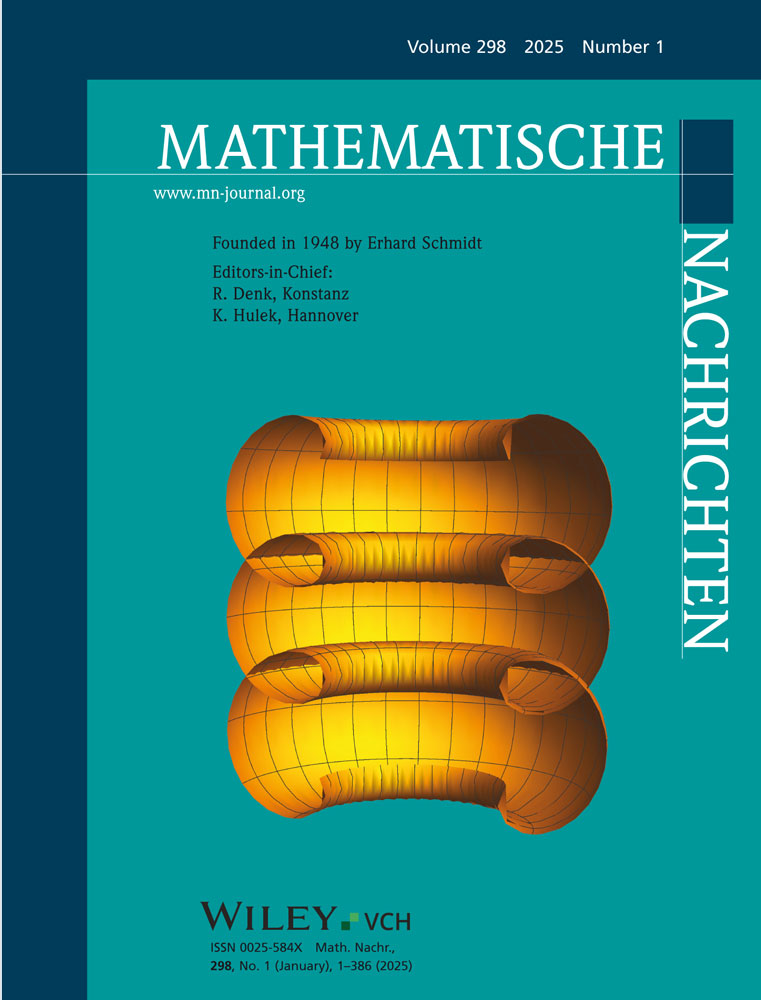Polyharmonic fields and Liouville quantum gravity measures on tori of arbitrary dimension: From discrete to continuous
Abstract
For an arbitrary dimension , we study:
- the polyharmonic Gaussian field on the discrete torus , that is the random field whose law on given by
where is the Lebesgue measure and is the discrete Laplacian;
- the associated discrete Liouville quantum gravity (LQG) measure associated with it, that is, the random measure on
where is a regularity parameter.
1 INTRODUCTION
We study Gaussian random fields and the associated Liouville quantum gravity (LQG) measures on continuous and discrete tori of arbitrary dimension. The random field on the continuous torus is a particular case of the copolyharmonic field introduced and analyzed in detail in [5] in great generality on all ‘admissible’ manifolds of even dimension. One of the main goals now is to study the approximation of these fields and the associated LQG measures by their discrete counterparts.
In particular, with the above choice of the normalization constant ,
Lemma 1.1. (See Lemma 2.4)
1.1 Characterization of the discrete polyharmonic field
Theorem 1.2. (cf. Theorem 3.4)The distribution of the discrete polyharmonic field on is given by the probability measure on .
1.2 Convergence of the random fields
As , the polyharmonic fields on the discrete tori converge to the polyharmonic field on the continuous torus. This convergence of the fields, indeed, holds in great generality.
For a precise formulation, one either has to specify classes of test functions on which admit traces on , or unique ways of extending functions on onto .
Our convergence results apply to the case of arbitrary dimension . In dimension , several results are available in the literature for the convergence of other discrete fractional Gaussian fields of integer order to the corresponding counterpart in the continuum, including, for example, the odometer for the sandpile model, or the membrane model. For a comparison of these results with those in this work, see Section 4.4.
1.3 Convergence of the random measures
The convergence questions for the associated random measures are more subtle. Again, of course, one expects that the Liouville measure on the discrete tori converge as to the Liouville measure on the continuous torus. This convergence of the random measure, however, only holds for small parameters .
Theorem 1.5. (cf. Thm. 5.5)Assume , and let be an odd integer . Then, in the sense of Definition 5.2,
Analogous convergence results hold for the random measures associated with the Fourier extensions of the discrete polyharmonic fields and the reduced discrete polyharmonic field, in the latter case even in the whole range of subcriticality .
1.4 Uniform integrability of the random measures
As an auxiliary result of independent interest, we provide a direct proof of the uniform integrability of (discrete, semi-discrete, and continuous) random measures on the multidimensional torus.
2 LAPLACIAN AND KERNELS ON CONTINUOUS AND DISCRETE TORI
2.1 Laplacian and kernels on the continuous torus
(a)
(b)
(c)
(d)
(e)
(f)
(g)
(h)
As for the Green kernel, we have the following representation.
Lemma 2.1.We have that
Remark 2.2.We conjecture that the convergence indeed holds everywhere but do not have a proof of this fact.
Proof.Since the series on the right-hand side is orthogonal, we find that
Lemma 2.3.The function
Proof.The heat-kernel representation in Equation (1) holds as in [6, Lemma 2.4]. For fixed , standard Gaussian upper heat kernel estimates provide the summability of the right-hand side in Equation (2), hence Equation (2) follows by differentiation under integral sign. Since is continuous for every on the whole of , we have that is continuous away from 0, and the differentiability of follows by standard arguments in multivariate calculus.
The constant is chosen such in such a way that has exactly logarithmic divergence.
Lemma 2.4. ([[5], Prop. 2.13])There exists a constant such that
Proof.Note that the estimate in Proposition 2.13 in [5] for the kernel of the -power of the Green operator holds not only for even but also for odd .
Remark 2.5.Let us note here that we rely—as in the proof of Lemma 2.3— on results in [5], proved there for copolyharmonic operators on admissible manifolds of even dimension . Copolyharmonic operators are pseudo-differential operators on with the same principal symbol as the (integer) power of the Laplace–Beltrami operator on , with lower-order correction terms granting their covariance under conformal transformations. We call a manifold admissible if the copolyharmonic operator is non-negative definite, with kernel exactly the one-dimensional subspace consisting of all constant functions. While the fact that a copolyharmonic operator has non-negative spectrum depends on the geometry of , the assumption of even is sufficient to grant that copolyharmonic operators have no zero-order term, so that their kernel contains all constant functions.
In the case of -dimensional flat tori with even, the copolyharmonic operators in [5] coincide with the (integer) power of the standard Laplacian on the torus. In this case however, it is readily verified for every integer that is non-negative definite and that its kernel is the one-dimensional subspace consisting of all constant functions. Thus, all results [5] concerned with the existence of Gaussian fields and their Gaussian multiplicative chaoses hold with identical proof on flat tori of arbitrary dimension.
2.2 Laplacian and kernels on the discrete torus
(a)
(b)
(c)
A complete ON basis of is given by the functions for whereas before and if and if .
Remark 2.6.For even , the previous definitions require some modifications. The set has to be re-defined as
(d)
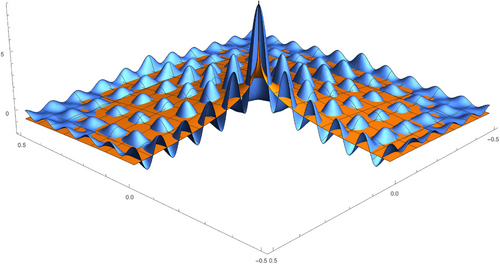
2.3 Extensions and projections
(a) Piecewise constant extension/projection
Here and in the following, the integral operators associated with kernels will be denoted by , resp. In general, these are regarded as integral operators on . If we want to regard them as integral operators on , we write instead.
(b) Fourier extension/projection
(c) Enhancement and reduction
Lemma 2.7.For ,
Proof.For with , and for ,
(d) Continuous versus discrete scalar product
Lemma 2.8.
- For and ,
- For any , the limit exists in if and only if
()
- For all and in ,
Proof.
- We prove the analogous assertion in the complex Hilbert space: for all and ,
since for everyThe claim for the real Hilbert space then follows choosing and for and analogously .
- Assume first that . Then, converges to in . This implies Equation (13). Conversely, assume that Equation (13) holds. Then, a martingale argument similar to that of Lemma 2.1 shows that is the limit in of .
- We only need to show the first equation. By linearity it is sufficient to show it for . In view of what precedes, we have
which proves the claim. The convergence of the series is ensured by Equation (13).
Remark 2.9.According to the previous lemma, in particular, for every ,
One can show (cf. proof of Theorem 4.11) that the latter series is absolutely convergent if . This is in accordance with the Sobolev embedding theorem which asserts that in this case and thus guarantees that the pointwise evaluation of (at the lattice points of ) is meaningful.
3 THE POLYHARMONIC GAUSSIAN FIELD ON THE DISCRETE TORUS
3.1 Definition and construction of the field
Throughout the following, fix integers and . For convenience, we assume that is odd, and we set .
Definition 3.1.A random field —defined on some probability space —is called polyharmonic Gaussian field on the discrete torus (shortly: discrete polyharmonic Gaussian field) if it is a centered Gaussian field with covariance function given by Equation (6).
Proposition 3.2.Given i.i.d. standard normals for on a probability space , a polyharmonic Gaussian field on is defined by
Here, for are the eigenvalues of the discrete Laplacian, see Equation (4), and the eigenvalue 0 is excluded in the representation of the random field.
Proof.For all ,
Alternatively, the polyharmonic field on the discrete torus can be defined in terms of the white noise on the discrete torus. Recall that a random field is called white noise on if the for are independent centered Gaussian random variables with variance . (This normalization guarantees that is distributed.)
Proposition 3.3.Given a white noise on , a polyharmonic Gaussian field on is defined by
Proof.For all ,
3.2 A second look on the polyharmonic Gaussian field on discrete tori
(a)
(b)
(c)
Theorem 3.4.The distribution of the discrete polyharmonic field on is given by the probability measure on . (Indeed, it is supported there on the hyperplane of grounded fields.) Furthermore,
Proof.For bounded measurable on ,
3.3 Reduced polyharmonic Gaussian fields on the discrete torus
Besides the polyharmonic Gaussian field on the discrete torus, we occasionally consider two closely related random fields and in the defining properties of which the eigenvalues of the discrete Laplacian are replaced by the eigenvalues of the continuous Laplacian or by , resp., with as in Equation (12).
Definition 3.5.We define
- the spectrally reduced discrete polyharmonic Gaussian field as the centered Gaussian field with covariance function
- the reduced discrete polyharmonic Gaussian field as the centered Gaussian field with covariance function
Similarly as before for , we obtain the following representation results.
Remark 3.6.
- Given a polyharmonic Gaussian field on , a reduced polyharmonic Gaussian field and a spectrally reduced polyharmonic Gaussian field on are defined by
- Given i.i.d. standard normals for , a reduced polyharmonic Gaussian field on is defined by
()and a spectrally reduced polyharmonic Gaussian field by()
3.4 Extensions of the polyharmonic Gaussian field on the discrete torus
We consider the following extensions of discrete polyharmonic Gaussian fields to the continuous torus. Recall the definition of and in Equation (7).
Definition 3.7. (Extensions (Figure 4))Given a discrete polyharmonic Gaussian field on as in Definition 3.1, we define
- its piecewise constant extension by
which is a centered Gaussian field on with covariance function
- its Fourier extension by
()which is a centered Gaussian field on with covariance function()
Similarly, given a spectrally reduced, resp. reduced, discrete polyharmonic Gaussian field , resp. , as in Definition 3.5, resp. on the discrete torus , we define (in the natural way)
- their piecewise constant extensions , resp. ;
- their Fourier extensions , resp. ;
4 THE POLYHARMONIC GAUSSIAN FIELD ON THE CONTINUOUS TORUS AND ITS (SEMI-)DISCRETE APPROXIMATIONS
- The basic objects are the polyharmonic field on the continuous torus and its discrete counterpart, the polyharmonic field on the discrete torus.
- Starting from the field on , we define its Fourier projection (i.e., eigenfunction approximation) , its piecewise constant projection , its natural projection , and its enhanced projection . All of them are Gaussian random fields on .
- Starting from the field on , we define its Fourier extension and its piecewise constant extension . Analogous extensions are defined for the spectrally reduced discrete field and the reduced discrete field on . All these extensions are Gaussian random fields on .
- - stands for piecewise constant extension/projection, for Fourier extension/restriction;
- - with denotes the respective extension of the discrete field ; similarly for and ;
- - with denotes the projection of the continuous field onto the respective class of fields of order on the continuous torus (Figure 3).
4.1 The polyharmonic Gaussian field on the continuous torus and the convergence properties of its projections
Definition 4.1.A random field on the continuous -torus is called polyharmonic Gaussian field if it is a centered Gaussian field with covariance function in the sense that
Proposition 4.2.The polyharmonic Gaussian field exists and can be realized in . Furthermore, the pairing continuously extends to all .
Proof.For even , the polyharmonic field to be considered here is just a particular case of the co-polyharmonic field considered in [5] on large classes of Riemannian manifolds. For flat spaces like the torus, the arguments for proving Theorem 3.2 and Remarks 3.4 and 3.5 there obviously apply also to odd .
Recall that we set .
Definition 4.3. (Projections)Given a copolyharmonic Gaussian field on , we define
- its Fourier projection onto the space , see Section 2.3(a), by
()which is a centered Gaussian field on with covariance function()
- its piecewise constant projection, cf. Section 2.3(b), by
()which is a centered Gaussian field on with covariance function()
- its enhanced piecewise constant projection (shortly: enhanced projection) by
()with as in Equation (25), which is a centered Gaussian field on with covariance function()
- its natural projection as the piecewise constant projection of its Fourier projection:
()with as in Equation (23) and as in Equation (25), which is a centered Gaussian field on with covariance function()
Remark 4.4.We note that the random fields and are piecewise constant, and may thus be equivalently regarded as either piecewise constant random fields on the continuous torus or random fields on the discrete torus .
Proof.For the reader's convenience, we briefly summarize the argument from [5] for the first assertion:
Proposition 4.6.For all ,
Proof.Since with , we obtain
Lemma 4.7.Let denote either of the subscripts and . Then,
- For all ,
- On ,
Proof.We prove the assertions for . A proof of corresponding assertions for is similar and simpler, and therefore it is omitted.
- Recall that . From (the proof of) Example 3.12 in [5] we know that as and, by Jensen's inequality,
Moreover, the latter goes to 0 as according toThe convergence of the last term here follows from the finiteness of . The convergence of the first term in the last displayed formula follows from the facts that for all and , that for all as , and that .
- Denote by the two-fold action of on functions of two variables, and put
()
Then, . The claimed convergence will follow from the three subsequent convergence assertions:
- (1) locally uniformly for all
- (2)
- (3) .
Corollary 4.8.Let denote either of the subscripts and . Then for all ,
Proof.To prove the first assertion, we estimate similar as in the proof of Proposition 4.6. The fact that implies and thus in turn
To prove the second assertion, we follow the argument in Proposition 4.6. That is, we consider
4.2 Identifications
Among the fields introduced above, we have the following identifications. We note that these identifications show that our notation of reductions/enhancements and projections/extensions is consistent, in the sense that it does not depend on the order in which the operations expressed by symbols are applied.
Lemma 4.9. (Fourier extensions/restrictions)Let be a polyharmonic Gaussian field on , and be a discrete polyharmonic Gaussian field on . Then,
- the spectral enhancement of the Fourier projection of coincides in distribution with the Fourier extension of ;
- the Fourier approximation of coincides in distribution with the spectral reduction of the Fourier extension of and with the Fourier extension of the spectrally reduced discrete polyharmonic field .
- the restriction to of the Fourier approximation of coincides in distribution with a spectrally reduced polyharmonic field (Figures 2-4).

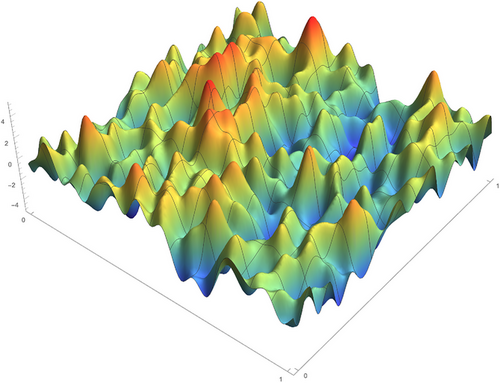
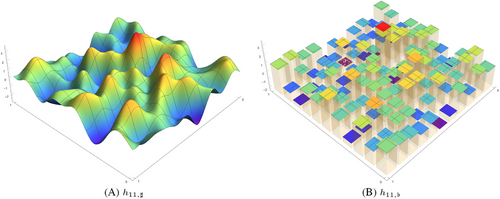
Proof. and follow from simple manipulations of the symbols. is an immediate consequence of .
Lemma 4.10. (Enhanced and natural extensions/restrictions)Let be a polyharmonic Gaussian field on , and be a discrete polyharmonic Gaussian field on . Then,
- the restriction to of the enhanced projection of coincides in distribution with ;
- the restriction to of the natural projection of coincides in distribution with the reduced discrete polyharmonic field ;
- the natural projection of coincides in distribution with the piecewise constant extension of the reduced discrete polyharmonic field .
Proof.Without loss of generality, let be given in terms of standard i.i.d. normal variables as
- We have
on . Thus for ,according to Lemma 2.7. Therefore, by Proposition 3.2, is distributed according to the polyharmonic Gaussian field on the discrete torus .
- We have
and thus for ,according to Lemma 2.7. Therefore, the restriction of to is distributed as the reduced discrete polyharmonic Gaussian field by the representation in Equation (19).
- is an immediate consequence of and the fact that is piecewise constant on .
4.3 Convergence of polyharmonic Gaussian fields on the discrete torus
We have the following first convergence result.
Theorem 4.11.Let be either , , or . Then, or all ,
Proof.We only show the assertion for .
Given , according to Lemma 2.8,
Theorem 4.12.Let be either , , or . Then, for all ,
Proof.We only show the assertions for .
By construction,
For the second claim, observe that
Theorem 4.13.Let be either , , or . For all ,
Proof.We only show the assertions for .
According to Proposition 4.5, we already know that . Thus, it suffices to prove . This follows according to
For the second claim, we use the fact that again by Proposition 4.5 for every ,
4.4 Related approaches and results
Remark 4.14. (Log-correlated Gaussian fields in the continuum)For , the field is the lower limiting case of the fractional Brownian motion with (regularity) parameter in , see, for example, [7, 12]. For , it is the celebrated Gaussian free field (GFF) on , surveyed in [16]. For , it coincides in distribution with the restriction of a GFF to a line (). For , it is a log-correlated Gaussian field surveyed in [7]. The conformal invariance of on is a consequence of the conformal invariance of the Laplace–Beltrami operator on flat geometries. The correct (i.e., conformally covariant) construction of log-correlated Gaussian fields in general non-flat geometries may be found in [5].
Remark 4.15. (Discrete-to-continuum approximation)To the best of our knowledge, no discretization/discrete approximation results are available for log-correlated Gaussian fields in dimension . In small dimension however, Gaussian fields analogous to are known to be scaling limits of different discrete models. For , in light of the celebrated universality property of GFFs, the field is a scaling limit for a huge number of different discrete Gaussian and non-Gaussian fields defined in various settings, from lattices to random environments, as, for example, the random conductance model [1]. For , the field is generated by the Neumann bi-Laplacian; the analogous field generated by the Dirichlet bi-Laplacian on is the scaling limit of the membrane model [10, 13], see [2, 14], as well as of the odometer for the divisible sandpile model [11], see [4]. We stress that our convergence results for different discretizations of hold in with , thus matching the same range of exponents as for the scaling limit of the sandpile odometer, see [3, Prop. 14]. On the other hand, the analogous scaling limit for the membrane model has so far been proven only in for , see [2, Thm. 3.11].
5 Liouville quantum gravity MEASURES ON DISCRETE AND CONTINUOUS TORI
We will introduce and analyze LQG measures on discrete and continuous tori. Our main result in this section will be that as the LQG measures on the discrete tori will converge to the LQG measure on the continuous torus .
An analogous convergence assertion in greater generality will be proven for the so-called reduced LQG measures, random measures on the discrete tori defined in terms of the discrete polyharmonic fields .
5.1 Liouville quantum gravity measure on the continuous torus and its approximations
We further make the following definitions of random measures on the common probability space supporting the polyharmonic field .
Definition 5.1.For , define
- the Fourier approximation on by
where denotes the Fourier projection (or eigenfunction approximation) of the polyharmonic field and the associated covariance function (which takes the constant value on the diagonal) as introduced in Definition 4.3.
- the piecewise-constant approximation on by
where denotes the piecewise constant projection of the polyharmonic field and the associated covariance function (which is constant on the diagonal) as introduced in Definition 4.3.
- the enhanced approximation on by
where denotes the enhanced projection of the polyharmonic field and the associated covariance function as introduced in Definition 4.3;
- the natural approximation on by
where denotes the natural projection of the polyharmonic field and the associated covariance function as introduced in Definition 4.3;
- the semi-discrete approximation (Figure 5) on by
where denotes the Fourier extension of the discrete polyharmonic field and the associated covariance function as introduced in Definition 3.7;
- the spectrally reduced semi-discrete approximation on by
where denotes the Fourier extension of the spectrally reduced discrete polyharmonic field and the associated covariance function as introduced in Definition 3.7.
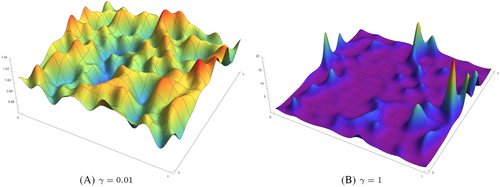
For a sequence of random measures on and a random measure , all defined on a same probability space , we further define the following mode of convergence.
Definition 5.2. (Convergence of random measures)We say that converges to as if both the following conditions hold:
- -a.s. weak convergence, that is,
- -convergence in , that is,
()
Theorem 5.3.Assume . Then, there exists a unique Borel random measure on , namely the polyharmonic LQG measure (also: polyharmonic Gaussian multiplicative chaos), satisfying—all convergences are in the sense of Definition 5.2
- as , and furthermore Equation (37) holds with -convergence replaced by -convergence if ;
- as ;
- as ;
- if , then as ;
- if , then as ;
- if , then as .
We note that the random measures and are functions of the discrete fields , while all other random measures above are functions of the continuum random fields .
Proof. and respectively hold by combining [5, Thms. 4.1 and 4.14] and [5, Thms. 4.1 and 4.13]. follows from Lemma 4.9 and .
In order to prove the remaining assertions, we verify the necessary assumptions in [5, Lem. 4.5], a rewriting in the present setting of the general construction of Gaussian multiplicative chaoses by Shamov [15].
Lemma 4.7 provides the convergence results for the regularizing kernel and for the covariance kernel . The uniform integrability—even -boundedness—of the approximating sequence of random measures follows from the -boundedness of the sequence of random measures as stated in and a straightforward application of Jensen's inequality with the Markov kernel :
Lemma 4.7 provides the convergence results for the regularizing kernel and for the covariance kernel . The uniform integrability of the approximating sequence of random measures follows from Theorem 5.6 in the last section.
According to Lemma 4.9, the Fourier extension of the discrete random field coincides in distribution with the field obtained from the continuous field by regularization with the kernel . Conditions and in [5, Lem. 4.5] can be verified exactly as in the proof of Lemma 4.7. The uniform integrability of the approximating sequence of random measures follows from Theorem 5.6 in the last section.
5.2 Liouville quantum gravity measures on the discrete tori and their convergence
Definition 5.4.For , define
- the polyharmonic LQG measure (also: discrete LQG measure) on by
where is the polyharmonic Gaussian field on the discrete torus and its covariance function (which takes the constant value on the diagonal of ) as introduced in Equations (14) and (6);
- the reduced discrete LQG measure on by
where denotes the reduced polyharmonic field in Equation (38) and its covariance function.
In order to prove the convergence of the random measures on the discrete tori as , we will restrict ourselves to subsequences for which the discrete tori are hierarchically ordered, say as for some fixed integer and . For convenience, we will assume that is odd.
Theorem 5.5.Let be an odd integer . Then,
Proof.Given as above, let us call a function on piecewise constant if it is constant on all cubes , , for some .
-
For a piecewise constant and all ,
()Indeed, the field is constant all cubes , , and Lemma 4.10 yields that the fields and coincide (in distribution) on the discrete torus . Thus, also the associated LQG measures of all cubes , , coincide.Hence, for a piecewise constant functions , the convergence
follows from the previous Theorem 5.3.For a continuous , the claim follows by approximation of by piecewise constant , . Indeed,
as , uniformly in , and similarly with in the place of . - For a piecewise constant , according to Lemma 4.10 for all ,
()Hence, for piecewise constant functions , the convergencefollows from the previous Theorem 5.3. For a continuous , the claim follows by approximation of by piecewise constant , , as in .
5.3 Uniform integrability of discrete and semi-discrete Liouville quantum gravity measures
Finally, we address the question of uniform integrability of approximating sequences of LQG measures. We provide a self-contained argument for -boundedness, independent of Kahane's work [9].
Theorem 5.6.Assume . Then
Proof.In order to prove Equation (41), recall from Equation (22) that for ,
For fixed , obviously is uniformly bounded in . Similarly, since for we have that for fixed ,
Thus, for Equation (41) to hold, it thus suffices to prove that
In order to prove the latter, we follow the argument of the proof of Lemma 2, p. 611 in [17]. To start with, we use the multi-dimensional Hausdorff–Young inequality, which can be found in [8, p. 248]:
Summing these terms over all yields
To treat the cases and , observe that . Thus, there exists a constant such that
In order to show Equation (42), note that
In order to show Equation (43), recall that with given is Equation (32). Thus by Jensen's inequality, Equation (43) will follow from
Corollary 5.7.If , then for each ,
- the family is -bounded,
- the family is -bounded.
- the family is -bounded.
ACKNOWLEDGMENTS
KTS is grateful to Christoph Thiele for valuable discussions and helpful references. LDS is grateful to Nathanaël Berestycki for valuable discussions on Gaussian Multiplicative Chaoses. The authors are grateful to an anonymous reviewer for suggestions which improved the presentation.
The authors gratefully acknowledge funding by the Deutsche Forschungsgemeinschaft through the project ‘Random Riemannian Geometry’ within the SPP 2265 ‘Random Geometric Systems.'
LDS gratefully acknowledges financial support from the European Research Council (grant agreement No. 716117, awarded to J. Maas) and from the Austrian Science Fund (FWF). His research was funded by the Austrian Science Fund (FWF) project 10.55776/F65 and project 10.55776/ESP208.
RH, EK, and KTS gratefully acknowledge funding by the Hausdorff Center for Mathematics (project ID 390685813), and through project B03 within the CRC 1060 (project ID 211504053). RH and KTS also gratefully acknowledges financial support from the European Research Council through the ERC AdG ‘RicciBounds’ (grant agreement 694405).
Open access funding enabled and organized by Projekt DEAL.
Open Research
DATA AVAILABILITY STATEMENT
Data sharing not applicable to this paper as no datasets were generated or analyzed during this study.



